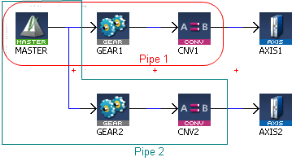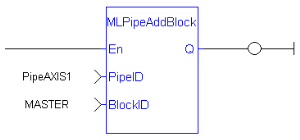MLPipeAddBlock
![]()
 Function
Function![]() A function calculates a result according to the current value of its inputs. A function has no internal data and is not linked to declared instances. - Adds a Pipe Block to a pipe.
A function calculates a result according to the current value of its inputs. A function has no internal data and is not linked to declared instances. - Adds a Pipe Block to a pipe.
Inputs
|
Input |
Data Type |
Range |
Unit |
Default |
Description |
|---|---|---|---|---|---|
|
PipeID |
DINT |
-2147483648 to 2147483647 |
N/A |
No default |
ID number of a created Pipe object. |
|
BlockID |
DINT |
-2147483648 to 2147483647 |
N/A |
No default |
ID number of a created Pipe object to add to the selected Pipe. |
Outputs
|
Output |
Data Type |
Range |
Unit |
Description |
|---|---|---|---|---|
|
Default (.Q) |
BOOL |
|
N/A |
Returns TRUE if the Pipe Block is added to the Pipe. See Pipe Network - General Rules for more information. |
Remarks
A Pipe contains an Input Pipe Block (Master, PMP, or Sampler), a Converter Output Pipe Block, and any Transformation Pipe Block that can be in between.
- The MLPipeAddBlock image shows two Pipes, both with the same Master Input Pipe Block.
- If Pipe 1 is created without using the Graphical Engine, these commands are used once a Pipe and the Pipe Blocks have been created:
- MLPipeAddBlock( PipeAXIS1, MASTER);
- MLPipeAddBlock( PipeAXIS1, MyGear);
- MLPipeAddBlock( PipeAXIS1, CNV1);
-
-
All Blocks in the Pipe Network are added to a Pipe automatically.
Code with MLPipeAddBlock commands are automatically generated and called in a program with PipeNetwork(MLPN_CREATE_OBJECTS).
When using the Pipe Network graphical engine to create Pipe Blocks, the user does not have to manually add MLPipeAddBlock commands to the Project.
FBD Language Example
FFLD Language Example
IL Language Example
Not available.
ST Language Example
//Add a block to a pipe
MLPipeAddBlock( PipeAXIS1, MyGear );
See Also
- MLCNVConnect
- MLPipeAct
- MLPipeCreate
- MLPipeDeact
- Pipe Network Functions for the PLC - MLPN_CREATE_OBJECTS









